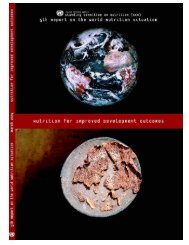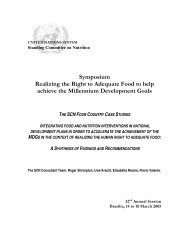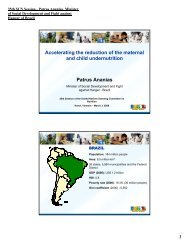12FEATURESwww.unsystem.org/scnGlobal Progress in Addressing Iodine Deficiency through <strong>Universal</strong> <strong>Salt</strong> <strong>Iodization</strong>:The Makings of a Global Public Health Success Story—The Second Decade (1995-2007)Kul C. Gautam, (Deputy Executive Director, UNICEF)Global progress towards the elimination of iodine deficiency disorders (IDD) has been tremendous. Although the story isnot yet over, the history and evolution of the global fight to eliminate IDD offers many lessons that could be applied toother public health efforts. Securing political commitment, ensuring iodized salt supply, forming national oversightcoalition and partnerships with the salt industry together with effective education, communications and monitoringsystems are key elements of the global success of the massive reductions in IDD through <strong>USI</strong>. As salt iodizationprogrammes mature, many countries have transitioned from relying upon donor-support to self-financing. Ensuringsustainability remains one of the key challenges in the global fight to eliminate IDD.Key words: IDD, iodine, iodine deficiency disorder, iodization, global, progress, programme maturation, salt, <strong>USI</strong>IntroductionIodine deficiency is the world’s single greatest cause of preventable mental retardation (Hetzel 1983). It isespecially damaging during early pregnancy and childhood. A mild iodine deficiency can cause a significantloss of learning ability, as well as other symptoms such as goitre, an abnormal enlargement of the thyroidgland. In its most severe form, iodine deficiency causes cretinism, stillbirth and miscarriage, and increasesinfant mortality (Delange 1994, 1999). A meta-analysis of 18 studies concluded that iodine deficiency alonelowered mean IQ scores by 13.5 points (Bleichrodt and Born 1994). The consequences of iodine deficiencyare thus measurable in terms of loss of economic productivity. The good news is that all of these disordersare easily preventable (UNICEF/WHO, 1994).The World Health Organization (WHO) and United Nations Children’s Fund (UNICEF) have recommended<strong>Universal</strong> <strong>Salt</strong> <strong>Iodization</strong> (<strong>USI</strong>) as a safe, cost-effective and sustainable strategy to ensure sufficient intake ofiodine by all individuals (UNICEF/WHO 1994).In fact, salt iodization could well be the most successful public health effort in the past two decades. And ifone takes into account the resulting drastic reduction in the risk of intellectual impairment caused by iodinedeficiency, salt iodization might even be considered one of the greatest public health achievements of the20 th Century. The World Bank estimated that each dollar dedicated to the prevention of Iodine DeficiencyDisorders (IDD) would yield a productivity gain of $28, supporting the widely held view that elimination ofiodine deficiency is one of the most cost-effective intervention programmes (World Bank 1994). A group ofthe world’s leading economists confirmed during the Copenhagen Consensus meeting that the benefit-costratio for salt iodization could be as high as 520, the highest among all interventions related to hunger andmalnutrition (Behrman 2004).Global efforts were initiated in 1990 when the World Health Assembly passed a resolution (WHA 43.2) whichadopted the goal of eliminating iodine deficiency as a public health problem in all countries by year 2000. <strong>Salt</strong>iodization programmes were accelerated when the necessary political will was generated through the “WorldSummit for Children” with the support of the United Nations (UN) System (UNICEF 1998). That Summit wasthe largest gathering of world leaders in history up to that time. It brought together 71 heads of State andGovernment and nearly 100 other leaders, mostly at the ministerial level. The World Summit set a goal ofvirtual elimination of iodine deficiency as part of its Plan of Action for child survival, development andprotection (UNICEF 1990). This support led to the development of an extraordinary global partnership ofcountries, UN, bilateral agencies, technical institutions and the salt industry.Prior to 1995 the iodization of salt was indicated only in countries that were recognized as having the IDDscretinism and goitre, based on surveys. After 1995 all countries had to iodize salt regardless of having aproven IDD problem and <strong>USI</strong> was globally adopted as the main strategy to eliminate IDD. This resulted in afar greater acceleration during the second period (1995-2000) (Shrimpton et al 2002). The original commitmentwas again renewed at the UN General Assembly Special Session on Children (UNGASS) in 2002. In itsDeclaration - “World Fit for Children”, leaders of some 190 high-level national delegations reinforced the needSCN NEWS # 35 back to contents
FEATURESwww.unsystem.org/scn 13to continue efforts toward sustained elimination of iodine deficiency by 2005 (UNICEF 2002a).In the early 1990s, adults and children with goitres would have been common sights in the rural areas ofcountries such as China, Indonesia, Nepal and Zimbabwe. Individuals suffering from severe neurologicaldeficits affecting hearing, speech and gait would not have been unusual. These clinical signs and symptomsof IDD were well-documented, but they represented only the most visible forms of the disorders. This resultedin a vast underestimate of the real problem: the loss of intellectual capacity in newborns due to an inadequateintake of iodine (Hetzel 1983). The shift to <strong>USI</strong> in the early 90s resulted in progress towards the goal ofelimination of IDD as a public health problem.Over the past decades UNICEF has advocated among policy makers, supported consultations, preparedguidelines, assisted countries with iodised salt plants, and worked with salt producers in quality monitoring. Incoordination with many other partners, UNICEF has been working in more than 100 countries to ensure theelimination of IDD around the world. It is a testament to the strong commitment of governments, the saltindustry, international nutrition groups, the UN system and other agencies that the most severemanifestations of IDD have nearly disappeared today and that in most countries the clinical manifestations ofiodine deficiency are becoming rare.Although the story is not yet over, the history and evolution of the global fight to eliminate IDD offers manylessons that could be applied to other public health efforts. A review of the progress made in the eliminationof IDD reveals the importance of partnerships with salt producers, the evolution of national policies, therefinement in monitoring, and many other factors that are contributing to this global success.Remarkable progressUNICEF estimates that only 20% of households in the developing world were using iodized salt in early1990s (UNICEF 2001). By 2000, following intensified efforts to eliminate iodine deficiency, this figure hadjumped to 70%. This is a remarkable achievement considering that salt iodization did not become the mainintervention to combat iodine deficiency in Asia until the mid-1980s, and that in much of Africa programmeswere not even started until the early 1990s.The most recent UNICEF global database of the State of the World’s Children 2007 indicated that the proportionof households in the developing world consuming adequately iodized salt officially remains at about 70%(UNICEF 2006). While this lack of change reveals the challenges that some countries face, it also reflectsprogramme maturation, which is significant but less visible. In addition, data limitations make it difficult to generatea picture of global trends over short periods of time.Progress since 1995 can be illustrated by the increase in the number of countries implementing salt iodizationprogrammes and achieving the <strong>USI</strong> goal of over 90% of households consuming adequately iodized salt(WHO 1996). By 2005, about 120 countries were implementing salt iodization programmes compared to 90 in2000. With more new countries reporting, our global database reflects a larger number of countries initiating<strong>USI</strong> programmes, and the global average may not well capture the achievements. The most recent estimatesindicate that 33 developingFigure 1. Countries by proportion of households consuming iodized salt in the last five yearscountries have now reached3533the <strong>USI</strong> goal, up from 21 in3028 272000, and that an additional252227 developing countries are212120well on their way to reaching17 1713this goal, having achieved1512about 70% household10coverage (Figure 1).Countries (N)50=90Household iodized salt consumption (%)UNGASS 2002SOWC 2007UNGASS 2002: Database 1997-2000 (N=90); SOWC 2007: Database 1998-2005 (N=121)WHO estimated that thenumber of countries withIDD as a public healthproblem is down by half fromback to contents SCN NEWS # 35







